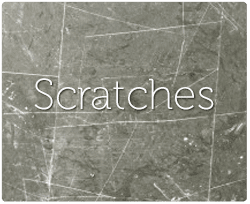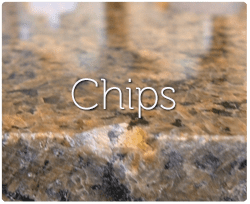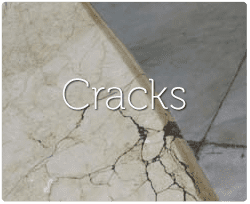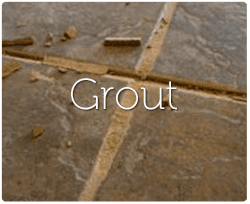Common Stone Problems

Marble, Limestone, Onyx, Travertine
Calcium-based stones like marble, limestone, onyx and travertine are easy to etch.
- Every marble kitchen countertop and bathroom vanity top will accumulate etchings in the form of “water spots,” circles and spray patterns from foods and cosmetics that are placed, dropped, spilled or sprayed on them.
- These can generally be removed from both polished and honed surfaces mechanically (with a small polishing machine) or often with a polishing cream and pad.
- Mechanically rehoning will also resolve the problem for already honed surfaces.
Granite
While it is not easy to etch granite, acids can do so. A mechanical repolishing or rehoning of the area in question must be done to resolve the issue.
How It’s Done
- Repolishing granite involves very hard and course pads that dig relatively deeply into the surface and as a result require quite a bit of time and expense.
- Some apparent etchings are really not etchings at all, but are a degradation of color.
- Granite colors (dark granites) are sometimes deepened with added resins. These can be bleached out by acids or other household chemicals.
- When this occurs, the application of a color-enhancing sealer can often solve the problem and restore the appearance.
Soapstone
While etching may appear in soapstone, it can generally be hidden by the application of mineral oil to the surface.
How It’s Done
- Mechanical removal is not advised. Soapstone is so soft that mechanical means may simply cut and chip the surface.

Marble, Limestone, Granite, Onyx, Travertine Scratches
Scratches must be removed mechanically by using the equivalent of sandpaper (diamond pads) to reach below the damage before applying finer and finer grit pads to bring back the original finish.
How It’s Done
- For surface scratches on marbles, limestones, onyx and travertine, this process is fairly routine and can generally be done on an isolated basis.
- Granite is a much harder and crystalline stone and as a result requires more extensive work. Nevertheless, the scratches can be eliminated, but at a much higher cost.
- Slate and soapstone scratches are best left untreated mechanically.
- Slate should be color-enhanced in order to try to hide scratches, while mineral oil can be periodically applied to the soapstone to fill them.

Marble Limestone, Granite Slate, Soapstone, Onyx, Travertine chips
Edges and cutouts (sink rims) of your stone counters will often be bruised by pots, pans or other household utensils, leaving chipped , ragged edges in their wake. Floor tiles may have chipped edges where they were improperly installed or damaged after installation.
How It’s Done
If the chips are large enough, epoxy can generally be applied and color matched to fill the resulting hole.
- Often, there is simply not enough surface area for the epoxy to form a strong bond and as a result, it may pop out over time leaving the hole exposed again.
- On flat surfaces, like filled travertines, marbles, and limestones, it is common for holes in the original stone to be filled with epoxy before fabrication. However, with age, these fills may begin to pop out and new ones may develop.
- These can be refilled with additional epoxy. Epoxy dries to a smooth, somewhat shiny finish which may not be perfect for honed surface repairs.

Marble, Limestone, Granite, Slate, Soapstone, Onyx, Travertine cracks
Cracks may appear on the surface of countertops. These hairline cracks can only be repaired by adding an epoxy.
How It’s Done
This usually requires widening the crack.
- As this promises to further extend the existing crack, it is usually best to watch the crack and hope that it stabilizes (stops getting larger) over time.
- Then, by keeping it regularly sealed, it may not require any further attention. For cracks that go all the way through a surface, a patch may be necessary.
- Cracked tiles may be patched, although the repair is often as noticeable as the original problem.
- Replacement of cracked tiles is dependent on the availability of comparable tiles and the ability to remove the damaged tiles without damaging the surrounding healthy tiles.
- Cracks are common along door thresholds and around plumbing fixtures. As long as they are not growing over time, there is no danger in living with them.

Stains
The most common stains found in natural stone are:
- Oil stains in granite, marble, and limestone
- Wine stains in marble and limestone
- Rust stains in white marble with gray veins
- Water stains from excessive moisture over long periods
How It’s Done
- Water staining can be prevented with regular sealing and can often be removed with a poultice.
- Rust stains are often unavoidable in showers and on vanity tops and can sometimes be removed with specialty chemicals and poultices.
- Oil stains can generally be prevented in granites and marbles with regular sealing and can be removed with a poultice if they are not too old and consequently too deep.
- Wine stains are usually not removable as they are chemically bound to the stone.
- Bleaches, however will sometimes work on white marbles, though this is not advised.

Grout
Grout problems usually take one of these three forms:
- Grout is dirty and no longer its original color
- Grout is cracked and missing in places
- Grout is uneven in color and appearance
How It’s Done
It is not usually necessary to remove and replace grout.
- If it is dirty and cannot be sufficiently cleaned, then the grout can be coated with a grout colorant, an epoxy seal that comes in dozens of grout colors.
- If the grout is cracked it can often be touched up in the affected areas.
- Finally, if the grout is uneven in appearance, a grout colorant can be applied to either make the color consistent throughout or to change the color completely.
